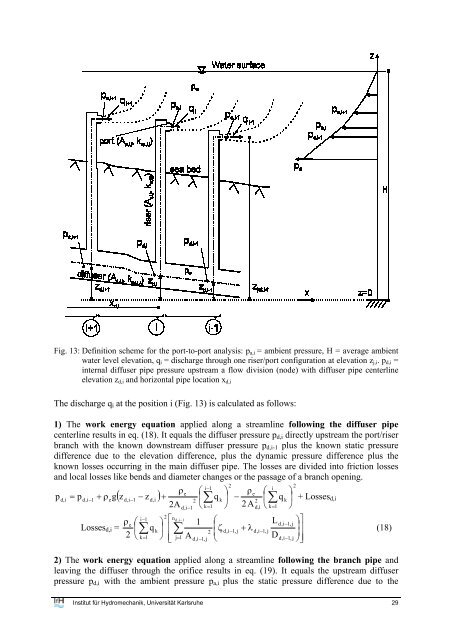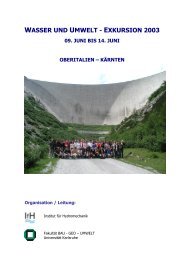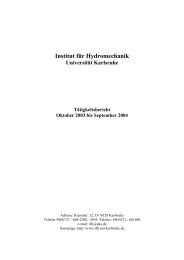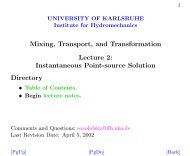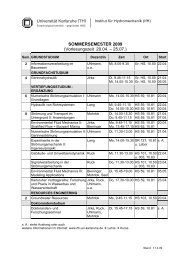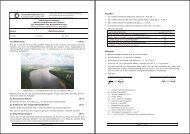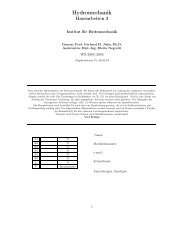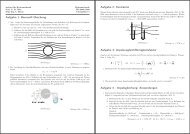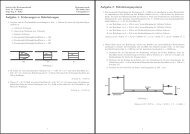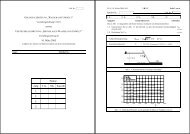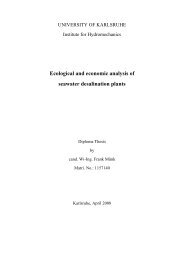Fig. 13: Definition scheme <strong>for</strong> the port-to-port <strong>an</strong>alysis: p a,i = ambient pressure, H = average ambient water level elevation, q i = discharge through one riser/port configuration at elevation z j,i . p d,i = <strong>internal</strong> <strong>diffuser</strong> pipe pressure upstream a flow division (node) with <strong>diffuser</strong> pipe centerline elevation z d,i <strong>an</strong>d horizontal pipe location x d,i The discharge q i at the position i (Fig. 13) is calculated as follows: 1) The work energy equation applied along a streamline following the <strong>diffuser</strong> pipe centerline results in eq. (18). It equals the <strong>diffuser</strong> pressure p d,i directly upstream the port/riser br<strong>an</strong>ch with the known downstream <strong>diffuser</strong> pressure p d,i-1 plus the known static pressure difference due to the elevation difference, plus the dynamic pressure difference plus the known losses occurring in the main <strong>diffuser</strong> pipe. The losses are divided into friction losses <strong>an</strong>d local losses like bends <strong>an</strong>d diameter ch<strong>an</strong>ges or the passage of a br<strong>an</strong>ch opening. p i−1 2 i ρe ⎛ ⎞ ρ e ⎛ d, i = p d,i− 1 + ρeg( z d,i−1 − z d,i ) + ⎜ q 2 ∑ k ⎟ − ⎜ q 2 ∑ k 2A d,i 1 ⎝ k 1 ⎠ 2A − = d,i ⎝ k= 1 Losses d,i = ρe ⎛ ⎜ 2 ⎝ i−1 ∑ k= 1 q k 2 ⎞ ⎟ ⎠ ⎡ ⎢ ⎢⎣ ⎛ ⎜ζ ⎝ n d,i −1 1 d,i−1, j ∑ − + λ 2 d,i 1, j d,i−1, j j= 1 A D d,i−1, j d,i−1, j L ⎟ ⎠ ⎞ 2 + Losses d,i 2) The work energy equation applied along a streamline following the br<strong>an</strong>ch pipe <strong>an</strong>d leaving the <strong>diffuser</strong> through the orifice results in eq. (19). It equals the upstream <strong>diffuser</strong> pressure p d,i with the ambient pressure p a,i plus the static pressure difference due to the ⎞⎤ ⎟ ⎥ ⎠⎥⎦ (18) Institut für Hydromech<strong>an</strong>ik, Universität Karlsruhe 29
elevation difference between <strong>diffuser</strong> centerline <strong>an</strong>d jet centerline, plus dynamic pressure difference between the <strong>diffuser</strong> <strong>an</strong>d one single jet plus the losses occurring in all pipe segments between these points. p d,i = p ( ) ( ) i 2 ρe 2 ρe ⎛ ⎞ α 2 iqi − ⎜ q 2 k ⎟ C A 2Ad,i ⎝ k= 1 ⎠ a,i + ρeg(z jet,i − zd,i ) + ∑ ρeq Losses i = 2 2 i ⎡ ⎢ ⎢ ⎣ n p,i ∑ j= 1 2 ⎛ ⎜ α ⎝ A i p,i, j c,i 2 p,i ⎞ ⎛ ⎟ ⎜ζ ⎠ ⎝ p,i, j λ p,i, jL + D p,i, j p,i, j ⎞ ⎟ + ⎠ n r ,i ∑ j= 1 ⎛ ⎜ ⎝ 1 A r,i, j + Losses i 2 ⎞ ⎛ ⎟ ⎜ζ ⎠ ⎝ r,i, j λ r,i, jL + D C c,i denotes the jet contraction coefficient either given by the user or calculated iteratively if Duckbill Valves are applied C c,i,DBV = α i q i / (V DBV,i A p,i ) with V DBV,i = duckbill jet velocity dependent on discharge. If multiple ports are applied a single jet discharge is q jet,i = α i q i with α i = 1/(number of ports at a riser at position i). Solving eq. (18) = (19) <strong>for</strong> <strong>an</strong> individual discharge q i gives i−1 2 nd ,i−1 2 ⎛ ⎞ 1 1 Ld,i− 1,j ( p − ) ( − ) ∑ ⎢ ∑ ⎜ ⎟ d,i 1 − pa,i + 2g zd,i 1 − z jet,i + ⎜ qk ⎟ + ζ − + λ 2 2 d,i 1,j d,i−1,j ⎥ ρ e ⎝ k= 1 ⎠ ⎢⎣ Ad,i− 1 j= 1 A − ⎝ D d,i 1,j d,i− j ⎠⎥ q = 1, ⎦ (20) i 2 2 2 np,i n α ⎛ ⎞ ⎛ λ ⎞ r ,i ⎛ ⎞ ⎛ λ ⎞ i ( ) ∑⎜ αi p,i,jLp,i,j r,i,j r,i,j + ⎟ ⎜ζ + ⎟ + ∑⎜ 1 L ⎟ ⎜ζ + ⎟ 2 p,i,j r,i,j C c,iAp,i j= 1 A p,i,j Dp,i, j j= 1 A r,i,j Dr,i, j ⎝ ⎠ ⎝ ⎡ For simple <strong>diffuser</strong>s equation (20) reduces to equation (21) if no risers <strong>an</strong>d no port configurations are applied <strong>an</strong>d the <strong>diffuser</strong> is just represented by simple holes in the pipe wall. Equation (21) is the one presented in Fischer et al., 1979 which has been used <strong>for</strong> simple <strong>diffuser</strong> calculations. i−1 2 ⎡ n −1 2 ⎛ ⎞ 1 d,i 1 ⎛ L ⎞⎤ d,i− j q = ( − ) + ⎜∑ ⎟ ⎢ + ∑ ⎜ζ + λ 1, ⎟ i C c,iA p,i p d,i−1 p a,i q ⎥ (21) k 2 2 ρ ⎝ ⎠ ⎢ d,i−1, j d,i−1, j e k= 1 = ⎣A d,i−1 j 1 A d,i−1, j ⎝ D d,i−1, j ⎠⎥⎦ Fischer et al. (1979) defined a loss coefficient C c,i <strong>for</strong> sharp-edged entr<strong>an</strong>ces: ⎠ ⎝ ⎠ ⎝ ⎛ r,i, j ⎠ r,i, j ⎞⎤ ⎟⎥ ⎠⎥ ⎦ ⎞⎤ (19) C c,i ⎛ 0.58 ⎜⎛ = 0.63 − ⎜⎜ 2g ⎝ ⎝ i−1 ∑ k= 1 q k 2 ⎞ ⎟ ⎠ ⎡ 1 ⎢ ⎢⎣ A d,i 2 −1 ⎤⎛ ⎜ 2 ⎥ ⎥ ⎜ ⎦ ρ ⎝ e ( p − p ) d,i−1 a,i ⎛ + ⎜ ⎝ i−1 ∑ k= 1 q k 2 ⎞ ⎟ ⎠ ⎡ 1 ⎢ ⎢⎣ A d,i 2 −1 ⎤⎞ ⎥ ⎟ ⎥⎟ ⎦⎠ −1 ⎞ ⎟ ⎟ ⎠ <strong>an</strong>d <strong>for</strong> bell-mouthed ports: C c,i ⎛ ⎜ = 0.975⎜1 − ⎝ 1 2g ⎛ ⎜ ⎝ i−1 ∑ k= 1 q k 2 ⎞ ⎟ ⎠ ⎡ 1 ⎢ ⎢⎣ A 2 d,i−1 ⎤⎛ ⎜ 2 ⎥ ⎥ ⎜ ⎦ ρ ⎝ e ( p − p ) d,i−1 a,i ⎛ + ⎜ ⎝ i−1 ∑ k= 1 q k 2 ⎞ ⎟ ⎠ ⎡ 1 ⎢ ⎢⎣ A 2 d,i−1 ⎤⎞ ⎥⎟ ⎥⎟ ⎦⎠ −1 ⎞ ⎟ ⎟ ⎠ 3 / 8 CorHyd furthermore allows to apply Duckbill valves also on simple <strong>diffuser</strong> systems <strong>an</strong>d there<strong>for</strong>e uses the previously defined additional local loss <strong>for</strong>mulations, which are additionally integrated in the calculations of the coefficient C c . Institut für Hydromech<strong>an</strong>ik, Universität Karlsruhe 30
- Page 1 and 2: Universität Karlsruhe Institut fü
- Page 3 and 4: Acknowledgments The authors like to
- Page 5 and 6: 10.1 Local loss formulations: Divis
- Page 7 and 8: 1 Introduction CorHyd is a computer
- Page 9 and 10: Fig. 1: Outfall configuration showi
- Page 11 and 12: where j 0 denotes the buoyancy flux
- Page 13 and 14: 2.4 Manifold processes Pipe hydraul
- Page 15 and 16: Fig. 8: Local port/riser branch los
- Page 17 and 18: Table 2: Local loss formulations Ty
- Page 19 and 20: Gradual contraction (Idelchik 1986)
- Page 21 and 22: Where H denotes the headloss, V duc
- Page 23 and 24: Table 3: Equivalent sand roughness
- Page 25 and 26: Institut für Hydromechanik, Univer
- Page 27 and 28: For a constant sea water level and
- Page 29 and 30: (16) solved for r in (15) and assum
- Page 31: 3.1.4 Automatic implementation of l
- Page 35 and 36: The iteration stops if the differen
- Page 37 and 38: Table 4: CorHyd subroutines and the
- Page 39 and 40: 4 Data Input Input can either be do
- Page 41 and 42: (ρ 0,max > ρ 0 ). Further sensiti
- Page 43 and 44: should allow for riser velocities,
- Page 45 and 46: Fig. 19: First input sub-window for
- Page 47 and 48: 10 7050.000 0.000 -2.500 11 7000.00
- Page 49 and 50: Fig. 22: Graphical output: Energy a
- Page 51 and 52: given dilution requirements and maj
- Page 53 and 54: 6.3 Off design conditions It was co
- Page 55 and 56: Table 5: Sensitivity of involved pa
- Page 57 and 58: Fig. 24: Side view and cross sectio
- Page 59 and 60: Fig. 27: Flow characteristics for d
- Page 61 and 62: under different flow conditions. Th
- Page 63 and 64: Fig. 32: Side view and cross sectio
- Page 65 and 66: Fig. 34: Flow characteristics for:
- Page 67 and 68: Fig. 36: Flow characteristics for:
- Page 69 and 70: Fig. 38: Flow characteristics for:
- Page 71 and 72: Table 6: Comparison of construction
- Page 73 and 74: seaward end, which can be prevented
- Page 75 and 76: Especially for this long diffuser a
- Page 77 and 78: Jirka, G.H., Doneker, R.L. and Hint
- Page 79 and 80: 10 Annex 10.1 Local loss formulatio
- Page 81 and 82: Institut für Hydromechanik, Univer
- Page 83 and 84:
Institut für Hydromechanik, Univer


